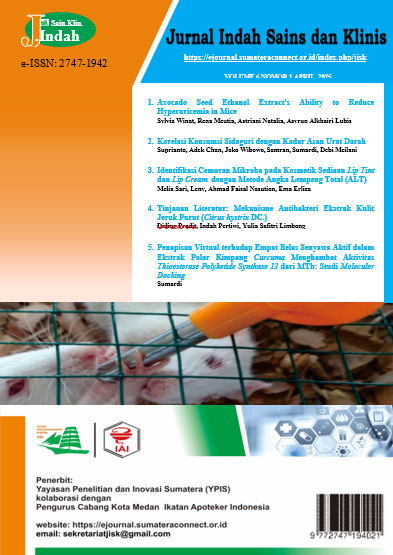Identifikasi Cemaran Mikroba pada Kosmetik Sediaan Lip Tint dan Lip Cream dengan Metode Angka Lempeng Total (ALT)
DOI:
https://doi.org/10.52622/jisk.v6i1.03Keywords:
Lip tint and lip cream, total plate count, microbial contaminationAbstract
Background: Repeated use of these products can lead to microbial contamination, making lip tint and lip cream susceptible to microbial contamination. Objective: To find contamination and identify the types of microbes contained in lip color cosmetics and lip creams. Methods: The methods used for bacterial contamination analysis include the Total Plate Count (TPC) test, bacterial identification on selective agar media, and Gram staining. Results: The Total Plate Count (TPC) results for lip tint samples after 1 month of use were 1.50 x 102 colonies/ml, 2 months 5.00 x 102 colonies/ml, and 3 months 5.50 x 102 colonies/ml. For lip cream samples after 1 month of use, the counts were 1.50 x 102 colonies/ml, 2 months 2.50 x 102 colonies/ml, and 3 months 15.00 x 102 colonies/ml. Pathogenic microbes detected in lip tint samples used for 1-3 months included S. aureus and C. albicans, while lip cream samples used for 1-3 months contained S. aureus, P. aeruginosa, C. albicans, and E. coli. All products that have been sampled for testing are within acceptable limits for Total Plate Count (TPC) according to BPOM Regulation Number 16 of 2024. Conclusion: All tested lip tint and lip cream samples met the required standards
Downloads
References
R. I. Tranggono and F. Latifah, Buku Pegangan Ilmu Pengetahuan Kosmetik. Jakarta: Gramedia Pustaka Utama, 2014.
“Peraturan Badan Pengawas Obat dan Makanan Nomor 23 Tahun 2019 Tentang Persyaratan Teknis Bahan Kosmetik,” BPOM. 2019.
J. M. Al-Rifaai, A. M. Al Haddad, and Y. S. N Alrefaei, “Types of Bacteria Found in Cosmetics Used By Female College Students in Kuwait,” Eur. J. Biol. Med. Sci. Res., vol. 9, no. 4, pp. 20–34, 2021.
V. E. Kaban, N. Nasri, Kasta Gurning, Hariyadi Dharmawan Syahputra, and Z. Rani, “Formulasi Sediaan Lip Cream Ekstrak Daun Miana (Coleus scuatellariodes [L] Benth.) sebagai Pewarna Alami,” INSOLOGI J. Sains dan Teknol., vol. 1, no. 4, pp. 393–400, 2022.
D. M. Wenas, J. Suardi, and W. Wahidin, “Uji Cemaran Mikroba pada Sediaan Lipstik Cair,” JUSTE (Journal Sci. Technol., vol. 1, no. 1, pp. 49–60, 2020, doi: 10.51135/justevol1issue1page49-60.
J. F. de Oliveira, H. Zenaide-Neto, A. C. B. de Sousa, R. R. A. Arruda, and U. Vasconcelos, “Presence of Filamentous Fungi in Powder and Semiaqueous Makeup,” Brazilian J. Dev., vol. 6, no. 7, pp. 54029–54039, 2020, doi: 10.34117/bjdv6n7-884.
F. M. Alshehrei, “Isolation and Identification of Microorganisms associated with high-quality and low-quality cosmetics from different brands in Mecca region -Saudi Arabia,” Saudi J. Biol. Sci., vol. 30, no. 12, p. 103852, 2023, doi: 10.1016/j.sjbs.2023.103852.
Rancangan Peraturan Kepala BPOM, “Rancangan Peraturan Badan Pengawas Obat dan Makanan tentang Persyaratan Cemaran Dalam Kosmetik,” no. November. Jakarta, pp. 1–8, 2023.
F. Monica, G. Qorry Aina, and D. Irianti Rukmana, “Gambaran Cemaran Bakteri Staphylococcus aureus pada Lipstik Cair Tester,” J. Kesehat. dan Pembang., vol. 13, no. 26, pp. 50–57, 2023, doi: 10.52047/jkp.v13i26.257.
I. B. O. Suyasa and N. Mastra, “Gambaran Methicillin Resistant Staphylococcus aureus (MRSA) Pada Petugas Kesehatan RSUD Wangaya Kota Denpasar,” Meditory J. Med. Lab., vol. 8, no. 1, pp. 46–52, 2020, doi: 10.33992/m.v8i1.1074.
E. D. Cahyani and A. Purwanto, “Edukasi Cemaran Mikroba Kosmetik Kelompok PKK RW 09 Kelurahan Klegen Kecamatan Kartoharjo Perumahan Bumi Antariksa Madiun,” J. Daya-Mas, vol. 5, no. 1, pp. 7–11, 2020, doi: 10.33319/dymas.v5i1.33.
C. J. Rahmah, P. Sri, and R. Isworo, “Analisis Mikrobiologis Produk Lipstik Cair yang Digunakan oleh Penata Rias,” J. Biol. Appl. Biol., vol. 4, no. 2, pp. 105–114, 2021.
Shintya awalindiniawaty dan sinta sasika novel, Kamus Farmakologi. Jakarta: CV. Trans info media, 2011.
D. Artanti, Modul Praktikum Media. 2018.
I. Ramadhani and Wahyuni, Dasar-Dasar Praktikum Mikrobiologi. Purwokerto: CV. Pena Persada, 2020.
C. Nuraini, Saida, Suryanti, and M. Nontji, “Isolasi dan Identifikasi Bakteri Rhizosfer Tanaman Jagung pada Fase Vegetatif dan Generatif,” pp. 24–30, 2020.
R. T. Utami et al., Mikrobiologi. Jambi: PT. Sonpedia Publishing Indonesia, 2023.
A. Sophia and Suraini, “Analisa Jamur candida albicans pada Swab Mukosa Mulut Perokok Aktif di Lubuk Buaya,” vol. 8, pp. 31–38, 2023.
A. Pohan and Kawilarang, “Perbandingan Bright Field Microscopy dan Phase Contrast Microscopy dengan Pengecatan Lactophenol Cotton Blue pada Jamur Dermatophytes,” J. Mikol. Klin. dan Penyakit Menular ( JMKPM ), vol. 3, no. 1, pp. 6–11, 2024.
Downloads
Published
Issue
Section
License
Copyright (c) 2025 Jurnal Indah Sains dan Klinis

This work is licensed under a Creative Commons Attribution-NonCommercial-ShareAlike 4.0 International License.









 This work is licensed under a
This work is licensed under a 
